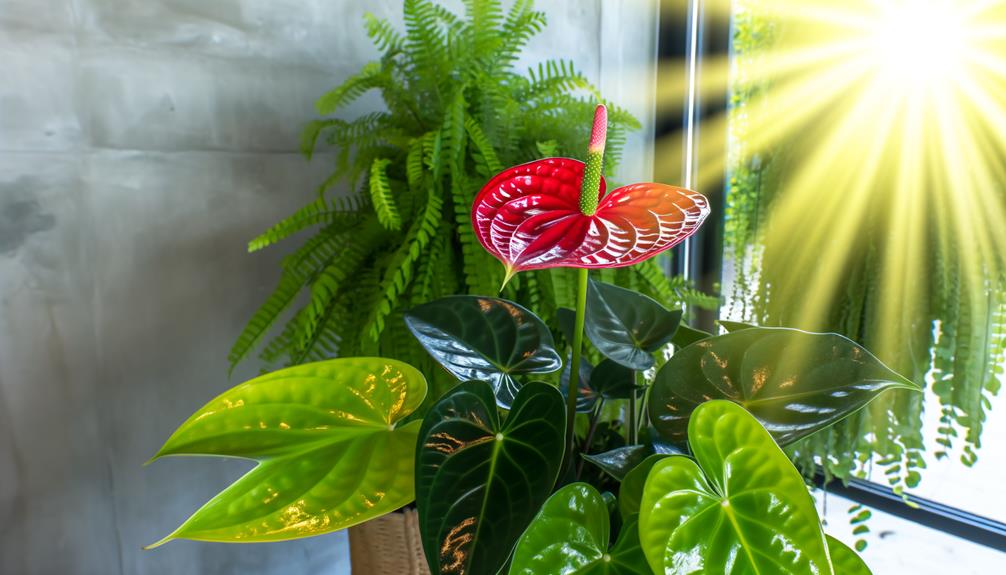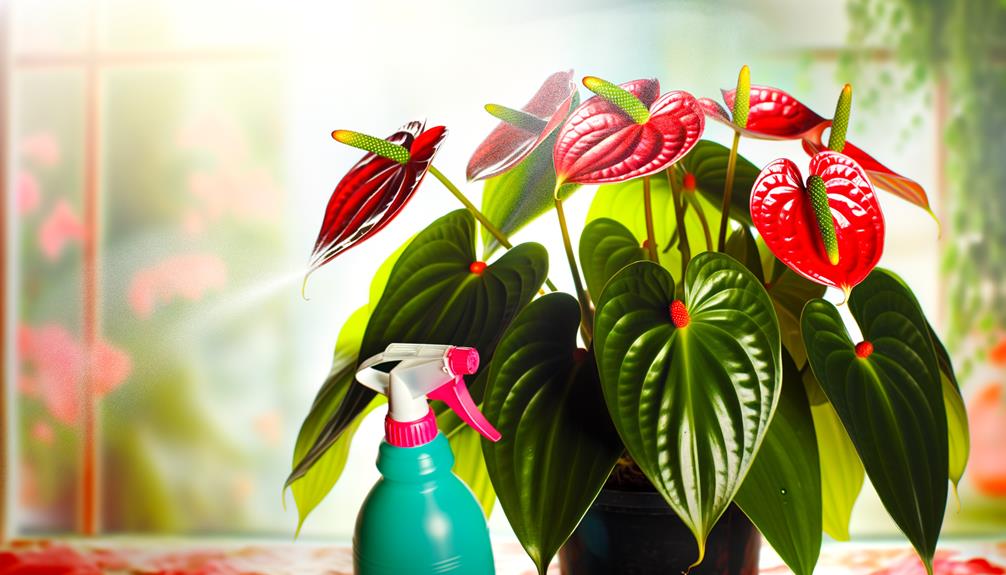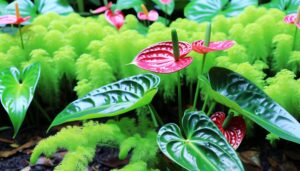How Long Do Anthurium Plants Live? Care Tips for Longevity
Anthurium plants typically live 5-10 years under ideal conditions. You’ll need bright, indirect light, a consistent temperature range of 70-85°F, and humidity levels between 60-80%.
Use well-draining soil to promote robust root development and prevent root rot; water the soil to keep it moist but not waterlogged. Employ a balanced, water-soluble fertilizer every 6-8 weeks during the growing season and regularly prune dead or yellowing leaves to enhance airflow.
Repotting every 1-2 years prevents root-bound conditions and sustains plant health. By following these guidelines, you can optimize your Anthurium’s lifespan and discover more advanced care strategies.

Key Takeaways
- Anthurium plants typically live 5-10 years under ideal conditions.
- Regular repotting and division can extend their lifespan.
- Proper watering techniques prevent root rot and enhance longevity.
- Bright, indirect light and consistent temperatures are crucial for healthy growth.
- High-quality, well-draining soil supports robust root development.
Average Lifespan of Anthuriums

The average lifespan of Anthurium plants, under ideal conditions, typically ranges from five to ten years. You’ll find that their growth rate is steady, particularly if soil quality is optimized.
High-quality, well-draining soil guarantees robust root development and nutrient uptake. Reproduction, mainly through division, can extend plant longevity by rejuvenating older plants.
Effective watering techniques, such as maintaining consistent moisture without waterlogging, are essential. Overwatering can lead to root rot, greatly reducing lifespan.
Conversely, underwatering can stunt growth and hinder reproduction. To maximize lifespan, balance soil moisture levels and guarantee proper drainage. With these practices, you’ll support healthy, long-lived Anthurium plants that thrive in your care.
Environmental Factors
Optimal environmental factors, like light, temperature, and humidity levels, greatly influence the health and longevity of Anthurium plants.
You should maintain ideal lighting conditions, providing bright, indirect light to prevent leaf scorch while promoting robust growth.
Temperature control is essential; aim for a consistent range between 70-85°F (21-29°C) to mimic their native tropical habitat.
Humidity levels should be kept high, ideally between 60-80%, to support the plant’s physiological processes.
Monitoring watering frequency is essential; overwatering can lead to root rot, whereas underwatering can cause dehydration.
Utilize a well-draining soil mix and make sure the pot has adequate drainage to balance moisture levels.
Adhering to these environmental factors can greatly extend your Anthurium’s lifespan.
Proper Care Techniques

Maintaining Anthurium plants involves a multifaceted approach, including precise watering schedules, regular pruning, and appropriate fertilization techniques to support growth and longevity.
You should monitor the watering frequency, ensuring the soil remains moist but not waterlogged. Inadequate hydration can lead to root rot.
For ideal sunlight exposure, place your Anthurium in indirect light; direct sunlight may scorch the leaves. Soil quality is vital—use a well-draining, organic-rich mix to promote healthy root systems.
A consistent fertilizing schedule, employing a balanced, water-soluble fertilizer every 6-8 weeks during the growing season, will provide essential nutrients.
Regularly pruning dead or yellowing leaves will enhance airflow and light penetration, further extending your plant’s lifespan.
Common Diseases
While ensuring proper care techniques are essential for Anthurium health, it’s equally important to recognize and address common diseases that can compromise the plant’s lifespan.
Fungal infections, such as root rot and anthracnose, are prevalent and typically result from overwatering or poor drainage. These infections manifest as yellowing leaves and stunted growth.
Bacterial diseases, like bacterial blight, cause leaf spots and wilting, often exacerbated by high humidity.
Effective pest control is vital, as pests like aphids and spider mites can introduce pathogens.
Additionally, nutrient deficiencies may weaken Anthuriums, making them more susceptible to disease.
Regularly inspect your plant for signs of trouble and act swiftly to mitigate issues, ensuring a healthy and prolonged lifespan for your Anthurium.
Extending Plant Longevity

Implementing evidence-based care practices greatly extends the longevity of Anthurium plants. Start by adopting precise pruning techniques to remove dead or yellowing leaves, promoting healthier growth.
Utilize growth stimulants like balanced fertilizers to enhance nutrient uptake. Regularly repot your Anthurium every 1-2 years to prevent root-bound conditions; use well-draining soil to optimize root health.
Adjust watering frequency based on seasonal changes: water more in warmer months and decrease during cooler periods. Monitor soil moisture to avoid overwatering, which leads to root rot.
Conclusion
Think of your anthurium plant as a marathon runner. With the right training—ideal light, proper watering, and pest control—it can thrive for years, often exceeding its typical 5-year lifespan.
Just as an athlete avoids injury with meticulous care, your anthurium will dodge common diseases with vigilant attention.
Remember Jane, who nurtured her anthurium for over a decade, proving that with dedication, your plant can truly go the distance.
Treat it well, and it will reward you.






